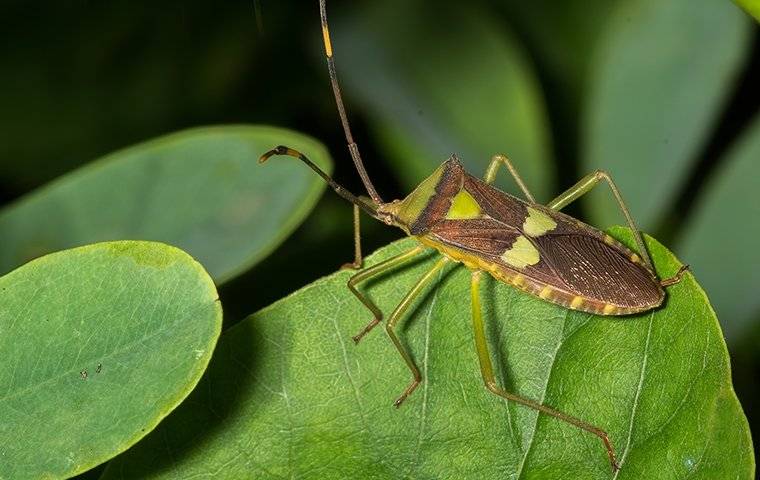
Leaf-Footed Bugs
Leaf-footed bugs in Charlotte are plant eaters that usually invade tomatoes and different plants found around the home. Once in the garden, they’ll remain in the region all late spring till fall swings to winter. Leaf-footed bugs are typically large and dark-colored. The red-legged leaf footer is for the most part dark with red to orange legs. The leaf-footed bug has a place with the Family Coreidae and is up to 1½ inch in size.

Its shading ranges from light to dark brown. Leaf-footed bugs are so named on the grounds that the rear legs are straightened and formed like the edges of leaves.
An assortment of leaf-footed bugs may relocate into homes looking for a spot to overwinter. Much of the time, it will be a small number of pests, however now and again, a single home or building may turn out to be especially appealing to these bugs. A few species will execrate a unpleasant solid smell when dealt with or irritated.
One of the more common leaf-footed bugs that may get into homes is known as the squash bug, Anasa tristis. Squash bugs stay overwinter as unmated adults and mate the accompanying spring after they come back to the garden.
Another known as the western conifer seed bug, Leptoglossus occidentalis, nourishes on the seeds of a few types of pines and Douglas fir and has progressively turned into a more common infrequent intruder bug in structures. Eggs are laid on any plants in late spring, and the nymphs feast upon needles and youthful cone scales. They develop into adults by mid-August and may travel to homes in fall to overwinter.
Habitat
These insects are found all through the United States where they live outside and feast upon different sorts of plants. The western conifer seed bug is a specific issue in many homes in the upper east U.S.
How To Prevent & Control
The best bug sprays against leaf-footed bug are an expansive range, pyrethroid-based bug sprays, for example, permethrin. In any case, these items are very lethal to honey bees and helpful bugs. Insecticidal cleanser or botanicals, for example, neem oil or pyrethrin, may give some control of the pest instead.
Once inside structures, leaf-footed bugs might be troublesome, if not unimaginable, to thoroughly kill. Counteractive action is the best system. Seal outside cracks and gaps on the home or building’s outside. Furnish vents with tight-fitting bug screens. If leaf-footed bugs are inside the property, fixing cracks in windows and door jambs can deny the bugs access to the inside of the home or business.
When attempting to determine the seriousness of the issue, search for them congregating on the sunny side of your home. Cool fall nights and temperature drops make them look for harborage for the approaching winter. Houses and different structures kept warm amid these months have ended up being phenomenal perch areas for leaf-footed bugs amid this time.
To stop the pest infestation, treat the siding on your home with CYPERMETHRIN blended at 1 oz per gallon. 1 gallon of blended arrangement will conceal to 500 sq/ft and ought to be connected as required; once per month for aversion.
Customer Reviews
-
“He spent time educating us about "pests" and provided information regarding services with GoForth.”- Joyce C.
-
“Texted me before coming. Worked with me playing musical rooms with my dogs. I'll see how things are.”- Constance E.
-
“Amazing response time, reasonable prices, great customer service. Tevin was thorough and confident in his plan to fix our horrendous fire ant problem. We have had negative experiences with prior exterminators and probably waited way too long to call Go-For”- Ashley T.
-
“- Toya B.
We have been customers for almost 7 years for a reason. Our technician is the best. He always knows exactly how to address whatever pest has decided to bother us. We have referred them to many of our neighbors. Well worth the cost not to have to worry a
” -
“Answered all my questions and I felt their pricing was very reasonable.”- Deborah J.
-
“Brian went above and beyond what was expected, and I hope I get him again as my technician for future services!”- Tam L.
-
“He was thorough with inspecting and treating our home, which I really appreciate, and he took the time to answer my many questions.”- Jasmine B.
-
“Love the detailed summary and pics of what he did and saw! And did I mention how wonderful Olivia was to get us all set up?!!”- Beechy A.


Over the years, we’ve boiled down our mission to a core set of values:
-
Give A CrapDelight others by owning your role and saying yes. Take pride in how you appear & act & every other detail of the job. Be on time, attentive, & enthusiastic. Act as if the buck stops with you on every aspect of the job.
-
Chase PerfectionChase Perfection, knowing full well we will not reach it, but along the way we will catch excellence. Have a sense of urgency; Go-Forth Time - right now might be the only time you have to get it right.
-
Dig Deeper
Be an action-oriented professional that makes decisions based on evidence rather than stories & assumptions. Stay curious. Data can speak for itself.
Understand the cause of the fire rather than rushing to extinguish it.
-
Fight For SimplicityKeep it simple & consistent. Focus on how things should be done every time.
-
Face It, Fix ItConfront challenges directly and address issues head-on. A bias for action and powerful conversations drive our progress. It’s about getting it right rather than being right.
-
Grow!Growth is our purpose. Growing as people & growing our business.